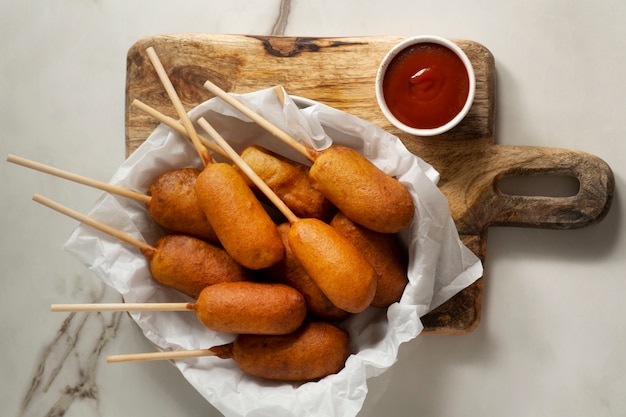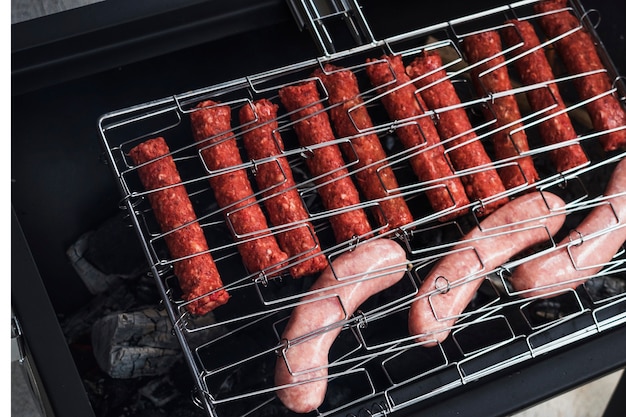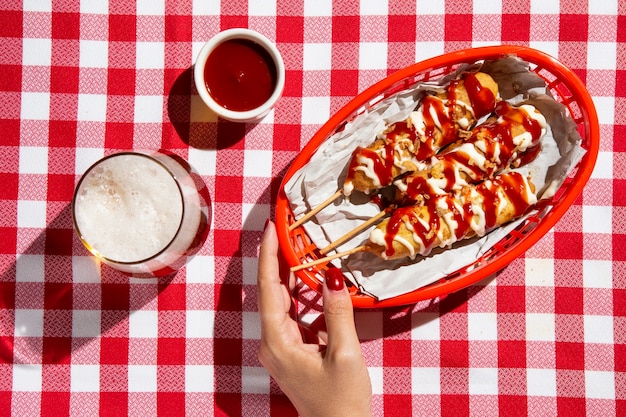Ah, bratwurst. Those delectable, juicy sausages that are synonymous with German cuisine. They're not just for Oktoberfest, mind you. Bratwurst can grace your table any day of the week, and I'm here to share my years of experience in transforming these little bundles of flavour into culinary masterpieces.
This guide is your one-stop shop for all things bratwurst, from choosing the perfect sausage to mastering the grilling technique. We'll dive into the history, explore the different varieties, and even delve into the finer details of cooking. Whether you're a seasoned grill master or a kitchen novice, this guide will have you confidently whipping up a batch of these delicious sausages that'll have your guests begging for more. Get ready for smoky flavour, sizzling satisfaction, and a culinary adventure that'll leave you wanting more!
(Part 1) Understanding Bratwurst

A Journey Through sausage history
Let's take a trip back in time, shall we? The history of bratwurst is as rich and flavorful as the sausage itself. The earliest mention of this beloved sausage dates back to the 14th century, where it was already a popular food among the common folk in Germany. It's a testament to its enduring appeal that bratwurst has remained a culinary icon for centuries.
You see, the beauty of bratwurst lies in its versatility. It’s a blank canvas waiting for your culinary creativity. While traditional recipes often feature a combination of pork and veal, seasoned with caraway and marjoram, you’ll find countless variations throughout Germany. Each region boasts its own unique take on the classic bratwurst, with different spice blends and meat combinations that reflect their local traditions.
The Many Faces of Bratwurst
Bratwurst isn't just one type of sausage, it’s a whole family of them! Each region of Germany has its own unique interpretation of this culinary gem, resulting in a variety of sizes, meat combinations, and flavour profiles.
Here are a few of the most popular types of bratwurst:
- Nürnberger Bratwurst: These tiny, bite-sized sausages are famous for their delicate flavour and are traditionally grilled over charcoal. Imagine a delicate blend of pork and veal, seasoned with ginger, nutmeg, and mace. They’re the perfect finger food for a festive gathering, and their small size makes them ideal for sharing.
- Thüringer Rostbratwurst: This thicker sausage is known for its crispy, slightly charred exterior, often achieved by grilling over open flames. It's typically made from pork and veal, seasoned with caraway seeds, pepper, and garlic. The result is a robust flavour with a hint of smokiness, a true testament to the heartiness of German cuisine.
- Münchner Wei??wurst: This white sausage is a Bavarian specialty, traditionally served with sweet mustard and a pretzel. Made with veal and pork, it's known for its delicate, milky flavour. It's crucial to eat this sausage raw, as the casing is not edible. The milky flavour is a result of the sausage being made with veal and pork that hasn't been cured, giving it a unique and refreshing taste.
- Frankfurter Bratwurst: These longer sausages, typically served with mustard and a bread roll, are known for their robust flavour. They are usually made with pork and beef, and seasoned with a blend of traditional German spices. They are the quintessential bratwurst, known for their versatility and ability to be enjoyed in various ways.
(Part 2) Choosing the Perfect Bratwurst

Now comes the fun part - selecting your bratwurst. Choosing a good quality sausage is crucial to ensuring a delicious outcome. You can often find them pre-made at your local butcher shop or supermarket, but remember, quality matters!
The Art of Selecting Bratwurst
Here's a little insider tip: look for bratwurst that's plump, juicy, and has a natural casing. Avoid sausages that are dry or have a discolored casing. A good quality bratwurst will usually have a distinct sausage scent, but it shouldn't have a strong odour of preservatives.
You can also find bratwurst that is already pre-seasoned. This is convenient for those who don't want to go through the hassle of seasoning themselves. However, if you want a more personalized flavour profile, you can opt for unseasoned sausages and create your own blend of spices.
The Importance of Freshness
Freshness is absolutely key! If you’re buying pre-made bratwurst, make sure you store it properly in the refrigerator until you’re ready to cook it. Don't be afraid to ask your butcher about the date it was made, or check the packaging for an expiry date.
Honestly, cooking with fresh, quality ingredients is the secret to a successful culinary adventure. It’s a bit of a mantra for me, you know? You can’t expect a magnificent outcome if you’re starting with subpar materials. The freshness of the ingredients truly makes a difference in the final flavour and texture of your dish.
(Part 3) Preparing Your Bratwurst

So, you've got your perfectly chosen bratwurst. It's time to prepare them for their culinary transformation!
The Art of Defrosting
If your bratwurst is frozen, it's crucial to defrost them properly. The best way to defrost is to transfer them from the freezer to the refrigerator overnight. This gradual thawing process ensures the sausages retain their moisture and flavour. Avoid defrosting them at room temperature, as this can promote bacteria growth.
The Importance of Room Temperature
Once they’re defrosted, let your bratwurst come to room temperature before cooking. This will ensure even cooking and prevent the sausages from becoming cold and rubbery. This is a simple step that can make a big difference in the final outcome of your culinary masterpiece.
(Part 4) Mastering the Grilling Technique
Grilling is the classic way to cook bratwurst, and it's a method that delivers a delicious smoky flavour and a crispy exterior. Now, I'm a seasoned grill master, and I’m here to share my secrets.
The Ultimate Grilling Setup
For the best results, you want a hot grill. I usually preheat my gas grill to medium-high heat, around 400 degrees Fahrenheit. If you're using a charcoal grill, you'll want to use hot coals.
Remember, a clean grill is a happy grill. Make sure to clean your grill grates before you start cooking. This will help prevent the bratwurst from sticking and ensure even cooking.
The Secret to Perfect Grill Marks
Now, let’s get those beautiful grill marks. First, lightly oil the grill grates. This will prevent the bratwurst from sticking and also contribute to a lovely crispy exterior.
Place your sausages on the grill, ensuring they have enough space between them for even cooking. Close the lid and let them cook for about 5-7 minutes per side, until they develop a nice golden-brown colour. Don't rush it, folks! Patience is key here. You want those sausages to be perfectly cooked through and develop that satisfying char.
The Importance of internal temperature
One of my favorite tips for cooking perfect bratwurst is to use a meat thermometer. This will ensure your sausages are cooked through to a safe internal temperature of 155 degrees Fahrenheit.
(Part 5) Beyond the Grill
Grilling is fantastic, but sometimes you want to experiment with different cooking methods, right? You're not limited to the grill, my friend. There are other ways to create culinary magic with your bratwurst.
The Pan-Frying Method
Pan-frying is a great alternative to grilling. It requires minimal equipment and can be done indoors. Heat a heavy-bottomed skillet over medium heat, and add a tablespoon of oil.
Place your bratwurst in the skillet, making sure they're not overcrowded. Cook for 5-7 minutes per side, or until they’re golden brown and cooked through. You can also add some sliced onions or garlic to the pan for extra flavour. The pan-frying method allows you to control the heat more precisely, resulting in a consistent cook throughout the sausage.
The Oven-Baking Method
If you want a fuss-free way to cook your bratwurst, baking is a perfect option. Preheat your oven to 375 degrees Fahrenheit.
Place your bratwurst on a baking sheet lined with parchment paper. You can add a few tablespoons of water to the bottom of the baking sheet to prevent the sausages from drying out. Bake for about 20-25 minutes, or until the sausages are cooked through and golden brown. The oven-baking method is perfect for those who prefer a hands-off approach to cooking.
(Part 6) Delicious Accompaniments
Now, let’s talk about the perfect accompaniments to elevate your bratwurst experience. It’s all about creating a symphony of flavours.
Mustards: A Symphony of Flavors
Bratwurst and mustard are like two peas in a pod. They just go together! There are so many options to choose from, each with its unique flavour profile. Here are a few of my favourites:
- Sweet Mustard: A classic choice that complements the savory flavour of the bratwurst. The sweetness of the mustard balances out the richness of the sausage, creating a harmonious taste.
- Stone-Ground Mustard: A more robust and earthy mustard, perfect for adding a touch of depth to your bratwurst. It’s a little bit spicy, with a hint of peppery flavour.
- Honey Mustard: A sweet and tangy option that adds a delicious layer of complexity to your bratwurst.
- Dijon Mustard: A bold and tangy mustard that adds a kick to your bratwurst. It's a good choice for those who like a bit of heat in their food.
Sauerkraut: A Traditional Pairing
Sauerkraut is a traditional German accompaniment to bratwurst. It's fermented cabbage, known for its tangy flavour and its ability to cut through the richness of the sausage.
To make sauerkraut at home, you'll need to ferment shredded cabbage with salt and water. The fermentation process takes about a week and results in a tangy and sour flavour. If you don't have the time or inclination to make your own, you can find pre-made sauerkraut at most supermarkets.
Other Delectable Options
Beyond mustard and sauerkraut, there are many other delicious accompaniments that can elevate your bratwurst experience. You can get creative with your choices!
- potato salad: A classic side dish that complements the rich flavours of bratwurst. I prefer a creamy potato salad, but you can also enjoy a German potato salad with vinegar and onions.
- Red Cabbage: A tangy and sweet side dish that adds a vibrant splash of color to your plate. To prepare red cabbage, you'll need to braise it with vinegar, sugar, and spices. It's a relatively easy dish to make and pairs well with the rich flavors of bratwurst.
- Bread Rolls: A soft and fluffy bread roll is perfect for wrapping around your bratwurst, providing a delicious and satisfying base for your sausage. A warm bread roll helps to soak up the juices from the sausage, creating a truly delightful experience.
- Roasted Vegetables: A healthy and flavorful option that can add a touch of sweetness and earthiness to your meal.
- Applesauce: A sweet and tart option that complements the savory flavors of the bratwurst. Applesauce is a classic accompaniment to pork dishes, and it works surprisingly well with bratwurst.
(Part 7) Tips for Serving and Enjoying Bratwurst
You’ve cooked your bratwurst to perfection. Now, it's time to assemble your culinary masterpiece and enjoy the fruits of your labour.
The Art of Presentation
Presentation matters, folks! Even the most delicious bratwurst will shine brighter with a little bit of visual appeal. Use a nice platter to display your sausages and accompaniments. You can also add some fresh herbs or sprigs of rosemary for a touch of elegance.
The Art of Sharing
Bratwurst is best enjoyed with friends and family. It's a social food that encourages sharing and conversation. Grab a plate, grab a sausage, and enjoy the moment!
The Art of Savoring
Don't rush your enjoyment. Take your time, savor each bite, and appreciate the rich flavors of your perfectly cooked bratwurst. It's all about the experience, the camaraderie, and the joy of delicious food.
(Part 8) FAQs
What are the best types of bratwurst for grilling?
There isn't a definitive answer to this question, as it all depends on personal preference. However, I find that thicker bratwurst, like Thüringer Rostbratwurst or Frankfurter Bratwurst, hold up well on the grill and develop a beautiful char.
Can I cook bratwurst in the microwave?
It’s not recommended to cook bratwurst in the microwave. microwave cooking often results in a mushy texture and uneven cooking. It simply doesn't deliver the same satisfying experience as other methods.
How long can I store cooked bratwurst?
Cooked bratwurst can be stored in the refrigerator for 3-4 days. To prevent dryness, wrap them tightly in plastic wrap or aluminum foil.
What are some interesting ways to use leftover bratwurst?
Leftover bratwurst can be used to create a variety of delicious dishes! You can add them to pasta dishes, make a hearty soup, or even use them to create a flavorful stuffing. The possibilities are endless, and you can get creative and experiment with different flavors.
What are some good beer pairings for bratwurst?
Bratwurst is a versatile food that pairs well with various beers. For a traditional German pairing, try a light and crisp German Pilsner or a wheat beer. If you're feeling adventurous, you can also try a darker beer, such as a Dunkelweizen or a Hefeweizen.
Can I freeze bratwurst?
Yes, you can freeze bratwurst. To freeze, simply place the sausages in a freezer-safe bag or container and freeze for up to 2 months. When you're ready to use them, defrost them in the refrigerator overnight.
What are some tips for preventing bratwurst from sticking to the grill?
To prevent bratwurst from sticking to the grill, make sure to clean the grill grates before cooking. You can also lightly oil the grill grates or use a non-stick cooking spray.
What are some tips for ensuring bratwurst is cooked through?
To ensure bratwurst is cooked through, use a meat thermometer. The safe internal temperature for bratwurst is 155 degrees Fahrenheit. You can also check for doneness by piercing the sausage with a knife. If the juices run clear, the sausage is cooked through.
What are some tips for making bratwurst at home?
Making bratwurst at home is a fun and rewarding experience. You'll need a meat grinder and sausage casings. The basic ingredients for bratwurst are pork, veal, and spices. You can experiment with different spice blends to create your own unique flavor profile.
Everyone is watching

Perfect Rice Every Time: The Ultimate Guide to Cooking Rice
Cooking TipsAs a self-proclaimed foodie, I've always been a bit obsessed with rice. It's the foundation of countless cuisi...

Prime Rib Roast Cooking Time Chart: Per Pound Guide
Cooking TipsPrime rib roast. Just the name conjures images of lavish dinners, crackling fires, and hearty laughter. It’s ...

The Ultimate Guide to Cooking Asparagus: Tips, Techniques, and Recipes
Cooking TipsAsparagus. The mere mention of this spring delicacy conjures up images of vibrant green spears, crisp and burs...

Ultimate Guide to Cooking the Perfect Thanksgiving Turkey
Cooking TipsThanksgiving. Just the word conjures up images of overflowing tables laden with delicious food, the scent of r...

How Long to Bake Potatoes in the Oven (Perfect Every Time)
Cooking TipsBaked potatoes are a staple in my kitchen. They're incredibly versatile, delicious, and surprisingly easy to m...
